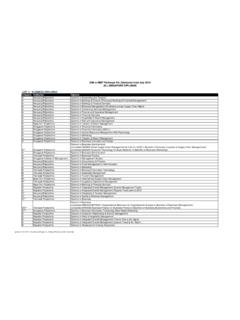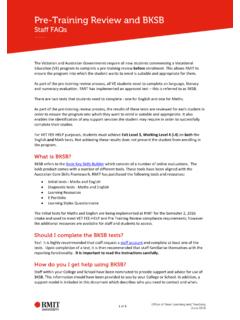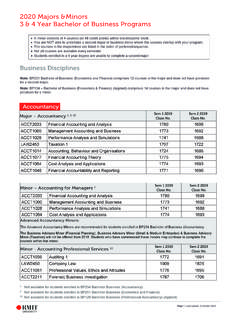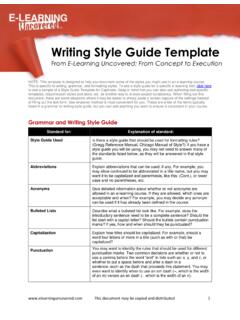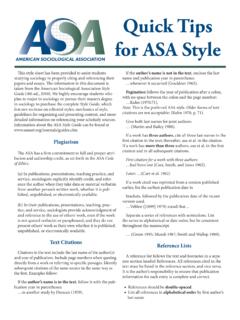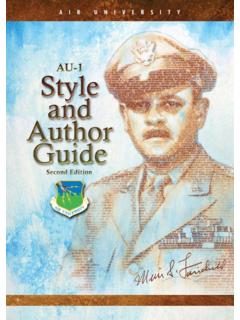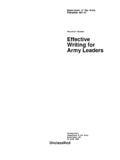Transcription of RMIT Writing Style Guide
1 RMIT Writing Style GuideAugust 2017 RMIT University Writing Style Guide August 20172 ContentsIntroduction 3 Principles of Style 4 Email protocols 5 Email etiquette 5 Subject lines 5 Content 5 People 5 Contact details 5 Names and titles 5 Qualifications (see also Academic, below) 6 Places 6 Addresses 6 Campuses 6 Colleges, portfolios, schools, groups and units 7 Universities 7 Website references 7 Academic 7 Bibliographies, citations and references 7 Programs and courses 7 Semesters 7 Numbers and dates 8 Dates 8 Dates in numerals 8 Time 8 Spans of dates.
2 Time and numbers 8 Numbers 8 Percentages 9 Amounts and currencies 9 Shortened forms 9 Abbreviations and contractions 9 Acronyms 9 Symbols 10 Punctuation 10 Apostrophes 10 Exclamation marks 10 Commas 10 Semicolons 10 Colons 10En dash 11 Brackets (parentheses) 11 Ellipses 11 Forward slash 11 Hyphenation 11 Quotations 11 Spacing 11 Plurals and apostrophes 12 Plural nouns 12 Possessive nouns 12 Contractions 12 Summary 12 Capitalisation 13 Minimal capitalisation 13 Maximal capitalisation 13 Formatting 13 Bulleted and numbered lists 14 Resources 14 Dictionaries and Style guides 14 RMIT 14 Words and phrases common problems 15 Expressions 16 Word usage 17 Preferred spellings and
3 Terminology 18 RMIT University Writing Style Guide August 20173 The RMIT Writing Style Guide provides guidelines for the preparation of content for all written communications, whether printed or digital. Please use this Guide as an easy-to-use reference and to help maintain a consistent and professional Writing Style across the in consultation with staff across the University, the Style Guide is based on major Writing references as well as on accepted RMIT Style . If you have any queries or suggestions for amendment at any stage, please contact Pauline Charleston in RMIT Communications: RMIT University Writing Style Guide August 20174 Principles of styleGood Writing should be:ClearThink about what you want to say, plan a logical structure, and write your message as clearly as possible. Use consistent headings, line spacing and formatting to help readers interpret the content easily and find information quickly within the why you are Writing (purpose), where your Writing will appear (context) and who will read it (audience), and write in a tone that suits all three elements.
4 Include only information that is relevant to your purpose. FreshAvoid clich s and buzzwords (see Page 18), repetition and unexplained acronyms. Aim for strong Writing with precise, meaningful words and meaningful, unpretentious language that readers will understand. Avoid using euphemisms (vague or meaningless expressions) and pompous phrases where there is a more concise and familiar way to convey your meaning (see Page 18). Use technical jargon only if it will be understood by your audience. For online content accessibility requirements, see the Web Accessibility in language that is readable and natural. Aim to write the way you speak, and change any stilted or verbose wording into everyday language that could be spoken out loud. If in doubt, try reading it aloud to yourself or a colleague. Avoid Writing long paragraphs of text. In most communications (especially online), text should be broken up into shorter chunks, using concise sentences and space to aid short words and paragraphs where appropriate, cut out any details that aren t absolutely necessary, split content into meaningful sections, and use bullet points where appropriate.
5 Appropriate and consistentYour tone could be formal, prosaic, procedural, conversational or punchy, as long as it is appropriate and is used consistently throughout the piece of Writing . In student communications or advertising copy, replace references to students or applicants with you where relevant. This Style of Writing (second person rather than third person) is more conversational and is in line with RMIT s image as an accessible and open university. Contractions such as we re and don t are appropriate in informal communications. ActiveIn most cases, use the active rather than the passive voice:Active: Ruth is preparing the : The letter is being prepared by what online grammar checks might indicate, the passive voice is not incorrect and is sometimes appropriate. For example:They were refused entry to the policy was drafted in of these sentences are in passive voice and are perfectly acceptable.
6 In the first case, it s not necessary or appropriate to name the person/s who refused entry. In the second case, the focus is on when the policy was drafted, not who drafted it. InclusiveWhen referring to broad groups rather than individuals, avoid gender-specific language by: nusing the plural ( they must ) instead of the third person ( he must , she must ):Candidates must provide copies of the application to their referees. Copies of the application must be provided to referees. nusing the gender-neutral second person pronoun you :You must provide a copy of the application to your gender-neutral nouns ( chair or chairperson rather than chairman , actor rather than actress , etc.).Be aware of any expressions or language which could exclude people on grounds of age, ethnicity or disability/ability level, and avoid highlighting factors like this about an individual unless necessary for a particular more advice on inclusion and diversity, see producing printed publications, take care to comply where appropriate with Vision Australia s guidelines to ensure that your content is legible and accessible to a broad audience.
7 These guidelines set out minimum standards for font type and size, formatting, colour contrast and text layout. RMIT University Writing Style Guide August 20175 Email protocolsEmail etiquetteWhen forwarding messages or adding a CC to replies, be aware this might be a breach of confidentiality as the sender might have intended that the message be read by you you are sending an email to a large number of addressees, or to more than one student, use BCC so that the email addresses are not displayed to all using IMPORTANT, URGENT and HIGH PRIORITY unless your message really is urgent, and limit the use of bold, italicised, underlined or coloured text to highlight information. If you overuse these options, they lose their impact when you need it most. If you use ALL CAPS, it will appear that you are shouting (and the text will be harder to read).Subject linesInclude a short and specific subject line.
8 When forwarding or replying to emails, ensure that the subject line still accurately reflects the content. Limit each email to one subject. ContentAs with a letter, include one main idea in each short paragraph and leave blank lines between each paragraph. Questions or requests (action points) should appear early in the email, usually after a short initial paragraph. Use Hi .. if you know the recipient; otherwise use the standard greeting Dear .. As a general rule, use the form of address that you would use in oral standard font type and size in email content (avoid personality fonts like Comic Sans).In emails as in other communications, clear Writing and correct spelling and grammar are important in ensuring professional standards and reader standard RMIT signatures that include the necessary details (title, school/unit name, building address, phone numbers etc).
9 Do not include motivational quotes and the like. PeopleContact details Publications and emails should always include a way for the reader to respond by telephone and email. Wherever possible, provide details in this standard format: Staff member s name Staff member s title School/unit name Portfolio/College name Address (building and street) Tel. +61 3 9925 XXXX Email address Web address(For more details, see Addresses.)The correct formats for telephone numbers are:Tel. +61 3 9925 2000 Mob. 0482 000 111 Names and titlesRefer to the About pages on the RMIT website or use the Find a staff member field to check the spelling, capitalisation and hyphenation of names, titles and school/unit names. Take care to use exactly as they appear. Examples:Pro Vice-Chancellor Business and Vice-President (not Pro Vice-Chancellor and Vice-President Business)School of Vocational Business Education (not Vocational Business School).
10 Professor Cheung Wai Chun (hyphenated or not, depending on what s in the Staff Member listing)Note that RMIT s Vice-Presidents are Vice-Presidents of RMIT, not of their College or portfolio. Hence, the correct title is, for example, Deputy Vice-Chancellor International and Vice-President, not DVC and Vice-President International. Use Professor or other senior titles, rather than Dr .RMIT University Writing Style Guide August 20176In formal text (including publications and RMIT News) and external correspondence, the following rules apply: nIndividuals full name at first mention (Jack Smith), then Mr/Ms/Mrs thereafter (Mr Smith said) nAcademics full title and name at first mention (Pro Vice-Chancellor Design and Social Context and Vice-President, Professor Paul Gough), then title and name thereafter (Professor Gough). The abbreviations Prof or Assoc are never used.
